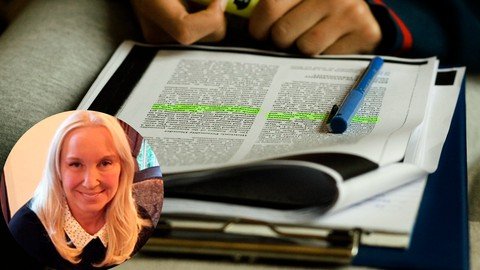
Last updated 6/2018
MP4 | Video: h264, 1280x720 | Audio: AAC, 44.1 KHz
Language: English | Size: 1.06 GB | Duration: 1h 12m
Dissect a scientific paper like a pro
What you'll learn
Describe the typical sections of a scientific paper
Discuss study design types and their implications for the study results
Review statistical terms needed for interpreting study results
Requirements
Interest in understanding clinical or scientific research studies but no background required.
Description
Get your head around the scientific literature! If you are a grad student, patient, medical student, clinician or researcher who needs to be able get their head around a scientific paper, then this course is for you. It's my belief that you don't need an extensive scientific background in order to be able to understand and make sense of a scientific paper. This course, in a straightforward way, will get you up and running in no time and help you form your own opinions about the science. Perhaps you do have a background in science. If that's the case, you will still get a lot out of this course and build on the skills that you already have. Save precious time! An important approach to reading a scientific paper is to determine up front what you hope to get from the paper and avoiding having to sit there and read the whole thing. In this course, I will highlight the sections that will be helpful to read depending on your reason for reading the paper. What makes me qualified to teach you? I'm Dr. Emma Nichols. I have a PhD in molecular biology and a Master's degree in technical communication. After deciding that the lab and academia weren't for me, I transitioned into medical writing. I've read many scientific papers in my time, and I've often had to digest papers quickly to meet deadlines as a medical writer and journalist. As a result, I've picked up a few shortcuts along the way! I've been privileged to help a few folks start their career in medical writing through my 6-week course. Here are a couple of reviews: "Emma's enthusiasm is contagious and she has an obvious passion for helping people starting out in the medical writing business." Gill S. "The direct, personalized, insightful mentoring I received from Emma during and after the course is indispensable as I navigate the field of medical writing. I highly recommend Emma's course to anyone serious about transitioning into medical writing." Kelly C This course will cover exactly what you need to know to read and interpret a scientific paper, including the following:The structure of a scientific article Important terms related to study population and trial design Different study designs and their implications Terms used to describe results Statistical significance and confidence intervals Sensitivity and specificity Adverse events and placebo effect Impact factor and peer review At the end, I will discuss three papers and talk about how to approach reading them from the perspective of a patient, a clinician, and researcher, respectively. What are the requirements? Most sections are suitable for people without a strong science background, but there is one section that goes into detail about different ways to report results and might be a bit slow going for someone who is not familiar with the topic. Likewise, some sections may be considered a bit rudimentary for people with a PhD or an MD, but it never hurts to brush up on your knowledge. In general, this course should appeal to anyone who has an interest of need to read the scientific literature. My promise to you I am here on this planet to teach and communicate (especially about science and medicine). If you have any questions about the course content or anything related to this topic, you can always post a question in the course or send me a direct message. Go ahead and click the enroll button, and I'll see you in lesson 1All the best, Emma
Overview
Section 1: Introduction
Lecture 1 Introduction
Section 2: Structure of a Scientific Paper
Lecture 2 Structure of a scientific paper
Section 3: Approach to reading a scientific paper
Lecture 3 Where to get more information
Lecture 4 What's in it for you?
Section 4: The methods section
Lecture 5 Study population and important terms
Lecture 6 Randomized controlled trials
Lecture 7 Cohort studies
Lecture 8 Case-control studies
Lecture 9 Case reports
Lecture 10 Meta-analyses
Lecture 11 Clinical trial phases
Lecture 12 Hierachy of study types
Section 5: The results section
Lecture 13 Ways in which results are reported
Lecture 14 Number needed to treat
Lecture 15 Kaplan-Meier curves and hazard ratios
Lecture 16 Statistical significance
Lecture 17 Confidence intervals
Lecture 18 Sensitivity and specificity
Lecture 19 Other considerations
Section 6: Bonus section
Lecture 20 Example 1
Lecture 21 Example 2
Lecture 22 Example 3
Lecture 23 Other courses on medical and scientific topics
Anyone wanting to better understand how to interpret the medical or scientific literature.,Patients, high school and college biology students, graduate students, medical students, scientists, and clinicians.
Homepage
https://www.udemy.com/course/how-to-read-and-interpret-a-scientific-article/Download from UploadCloud
https://www.uploadcloud.pro/2k7ggawzlmle/wsmxc.How.To.Read.And.Interpret.A.Scientific.Paper.part1.rar.html
https://www.uploadcloud.pro/q1djkw7b61ue/wsmxc.How.To.Read.And.Interpret.A.Scientific.Paper.part2.rar.html

https://rapidgator.net/file/86168905ce0254a796285be148153066/wsmxc.How.To.Read.And.Interpret.A.Scientific.Paper.part2.rar.html
https://rapidgator.net/file/ef97090b7f49f83fbf31a13ee34844a9/wsmxc.How.To.Read.And.Interpret.A.Scientific.Paper.part1.rar.html

https://uploadgig.com/file/download/36F407d1cE3460bd/wsmxc.How.To.Read.And.Interpret.A.Scientific.Paper.part2.rar
https://uploadgig.com/file/download/6e56898Fb86aEe35/wsmxc.How.To.Read.And.Interpret.A.Scientific.Paper.part1.rar

https://nitroflare.com/view/0B2767939EDFF6F/wsmxc.How.To.Read.And.Interpret.A.Scientific.Paper.part1.rar
https://nitroflare.com/view/7C65C3CAFF0CF59/wsmxc.How.To.Read.And.Interpret.A.Scientific.Paper.part2.rar
